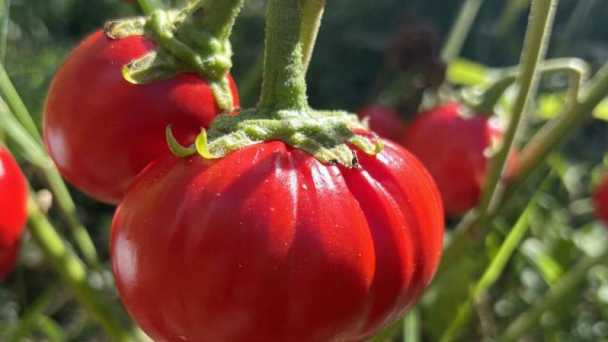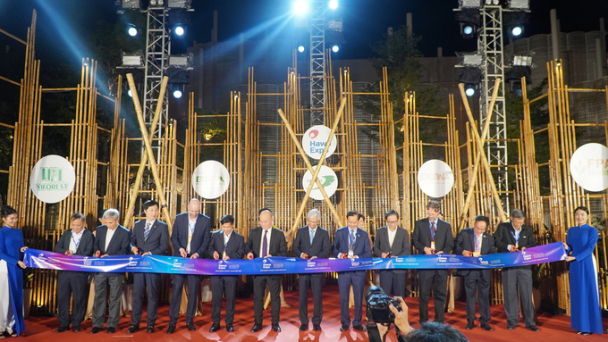March 6, 2025 | 15:55 GMT +7
March 6, 2025 | 15:55 GMT +7
Hotline: 0913.378.918
March 6, 2025 | 15:55 GMT +7
Hotline: 0913.378.918
The Hau River Farm is located a few kilometers away from Can Tho city on Tran Ngoc Hoang street, which is also the name of the Hero of Labor, former Director of Hau River Farm.

The KH6 canal is a unique waterway in Hau River Farm serving the transportation of local goods and agricultural products. Photo: Kim Anh.
The KH6 canal running parallel to a smooth asphalt road leads water directly from the Hau River, through the Thom Rom canal to the fields and farms for agricultural production. This unique waterway was formed several decades ago in order to transport local agricultural and aquatic products from the farms to the consumers.
The long-standing irrigation system in Hau River Farm has been considered to be one of the most comprehensive and model irrigation systems in Vietnam in the 1980s - a detail which Mr. Nguyen Thanh Phu, Director of Hau River Farm, often proudly informs tourists visiting the farm.
According to documents recording the formation and development of Hau River Farm, this land belongs to Co Do district, formerly O Mon district, in Can Tho city. The land in this region was largely deserted in 1954 and farmers mainly grew rice on the natural topography including mounds, natural canals, and so on. The investment in field improvement and irrigation was limited so farmers could only produce one floating rice crop per year with a low yield at 1.5 tons per hectare.
In compliance with the policy of military participation in production in February 1976, the Provincial Party Committee, Hau Giang Provincial People's Committee and Military Region 9 coordinated to establish a farm with a natural area of nearly 7,000 hectares. The farm, under the management of Hau Giang Provincial Army, was named "Quyet Thang". After over three years, the area was separated into two parts to be assigned to Tay Do Battalion for management and production. Hau Giang Provincial People's Committee decided to merge the area assigned to Tay Do Battalion into Hau River Farm in 1984.
According to Mr. Phu, Hau River Farm began operating by linking and cooperating with farmers to expand the land area and improve fields in the same year. The farm constructed a system of secondary, tertiary and infield canals to quickly remove acidity and wash alum. Additionally, the farm utilized machineries to renovate, scoop canals, level, and bulldoze fields, etc. As a result, rice production was improved, and seasonal rice productivity was stabilized, reaching 2.5 tons per hectare.

Rice production and trading activities at Hau River Farm are relatively active when the crop is in season. Photo: Kim Anh.
When the irrigation system received methodical investments, local farmers started pilot production by planting two rice crops per year. Scienctific advancements and new varieties were first introduced into the fields in 1995. Subsequently, the farm encouraged participants to convert the entire production area to double-crop rice at a yield of 9 to 10 tons per year. Consequently, the total output reached 48,000 tons, which was seven times higher than that in 1984.
In addition, the farm planted a large number of Melaleuca and Eucalyptus trees on the canal banks between the years 1982 and 1983 to create a source of raw materials for construction and processing of household furnitures.
The mechanization rate in agricultural production on the farm reached over 90% from 1979 to 1996. The electrification of daily life and production was enhanced and completed in 2000 with 17.2 kilometers of medium voltage lines and 33 kilometers of low voltage lines covering the entire farm.

The farm planted a large number of Melaleuca and Eucalyptus trees on the canal banks between the years 1982 and 1983. Photo: Kim Anh.
“A multi-layered dike system was invested jointly by locals and the farm. As a result, the production efficiency at Hau River Farm was vastly improved and unaffected by the floods. Subsequently, multiple large agricultural models have been formed and developed", Mr. Phu emphasized the results of investments in the farm's irrigation system.
Some of the aforementioned models include pig farms with a scale of 300 tons per year, and a breeding capacity of 1,500 pigs. Additionally, there are rice - fish farming models on 4,500 hectares of rice production land with an annual output of 1,500 tons of fish. Moreover, the farm produces fry and fingerlings for neighboring areas.
The farm built a processing factory for banana exports to the Soviet Union. The farm further expanded this strength in processing by establishing eleven food processing workshops for export; one-hundred-thousand-ton warehouse system; seven workshops for agricultural product processing, drying, salting, and canning; two household carpentry workshops with advanced processing technology for domestic and export; one seafood processing factory.
The farm was formerly a focal point for direct rice export and leading fertilizer import in the country.
After a 44-year eventful journey, Hau River Farm is managing and utilizing over 6,200 hectares of agricultural land. More than 5,600 of which have been leased to 2,568 households for agricultural production.
The former primary focus of the area was rice production. However, farmers have converted to growing fruit trees with high economic efficiency such as mango, longan, custard apple, jackfruit.
In addition, the farm currently has more than 300 hectares of aquacultural production area. The farm specializes in producing pangasius as raw materials for export processing factories. Specialized vehicles travel along the KH6 canal in order to transport commercial pangasius from production areas to processing factories.

Hau River Farm also supplies pangasius as raw materials for processing and export factories. Photo: Kim Anh.
The farm has constructed agricultural product wharfs and service warehouses to serve the production, consumption of agricultural products, and business activities. On the other hand, the farm features a modern rice drying system and a grain separator that provides high quality post-harvest services with the ability to dry over 6,000 tons of rice and separate over 3,000 tons of grain.
Hau River Farm aims to develop a fruit farm in association with eco-tourism on an area of 14 hectares from 2020 to 2025. So far, the basic construction phase has been completed with a variety of fruit trees, fish, beekeeping for honey, and culinary service area.

Farmers acquire land at the Hau River Farm in order to grow fruit trees and have a stable life. Photo: Kim Anh.
Mr. Nguyen Thanh Phu emphasized that the farm grew from a deserted land to a rich region with a diverse ecosystem. The local irrigation canals and roads facilitate effective agricultural production and goods circulation. Consequently, Hau River Farm has become a large, concentrated raw material area, a promising land for many people.
Can Tho City People's Committee established the administrative unit of Thoi Hung commune in Hau River Farm area with eight affiliated hamlets in 2004. Subsequently, socio-political organizations, electricity systems, roads, schools, and stations previously managed by the farm were handed over to the local government continued management, usage, and improvement. As a result, the farm enters a new stage of development under the management of both the local government and Hau River Farm.
Thoi Hung commune was recognized as a newly enhanced rural commune on December 18, 2020. The commune has mobilized and established many potential cooperatives such as the Thoi Hung custard apple wine cooperative. Additionally, the commune successfully built the brands of Thai Thanh longan, Kim Nhien custard-apple tea, etc.
Translated by Nguyen Hai Long

(VAN) The ecological model 'Rice Calls the Cranes Back' in Dong Thap becomes a highlight in integrating agricultural production with habitat conservation in Tram Chim National Park.

(VAN) Bigger, tastier tomatoes and eggplants could soon grace our dinner plates thanks to Johns Hopkins scientists who have discovered genes that control how large the fruits will grow.

(VAN) Deputy Minister Le Cong Thanh states that Vietnam and South Korea need to strengthen cooperation in water resource management and river basin management.

(VAN) The rise in coffee prices has led to an increase in the level of investment in care from farmers. As a result, the amount of waste from pesticides and fertilizers has surged dramatically.

(VAN) HawaExpo 2025 opened at White Palace, Thu Duc City, on the evening of May 4, featuring 350 booths from Vietnam's leading exporters of interior and exterior furniture.

(VAN) At the Government meeting on the morning of March 5, Prime Minister convened local leaders from the Mekong Delta to discuss rice production, consumption and exports.

(VAN) The profitability of the one-million-hectare high-quality, low-emission rice program in Kien Giang has increased, with producers earning an additional 10 million VND per hectare in comparison to earlier cultivation methods.